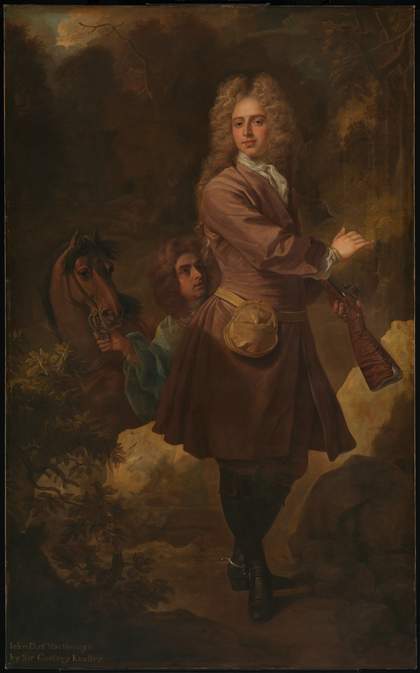
Fig.1
John Closterman
Portrait of a Gentleman c.1700, prior to recommended removal of yellow varnish
Oil paint on canvas
2400 x 1486 mm
T1548
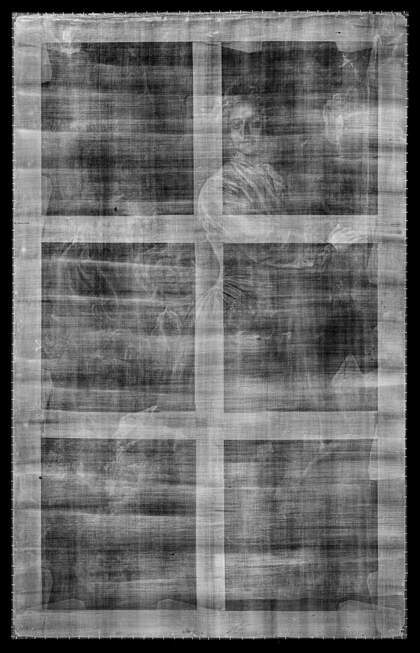
Fig.2
X-radiograph of Portrait of a Gentleman
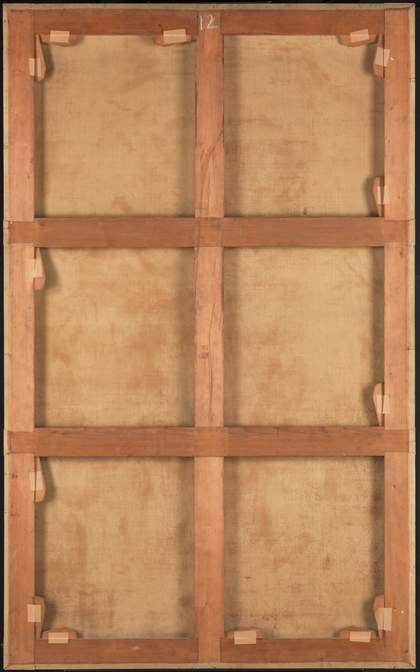
Fig.3
Reverse of Portrait of a Gentleman
The painting (fig.1) is executed in oil paint on canvas (fig.2) which has been glue-paste lined and mounted on a non-original, 7-membered stretcher (fig.3). The support appears to be in good condition with no significant distortions or other issues.
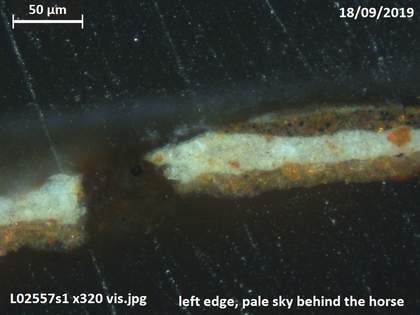
Fig.4
Cross-section of paint taken from the left edge, the pale sky behind the horse, showing the thin pale blue paint for the sky which was extended over brown foliage, and the two preparatory layers
The preparatory layers consist of a thick, warm off-white layer of lead white and golden ochre over an equally thick mid-brown layer of yellow and golden ochres and very coarse Vandyke brown in chalk (fig.4).1 The upper ground has considerable lead soap aggregate formation, which makes it appear more transparent and darker than when first painted.
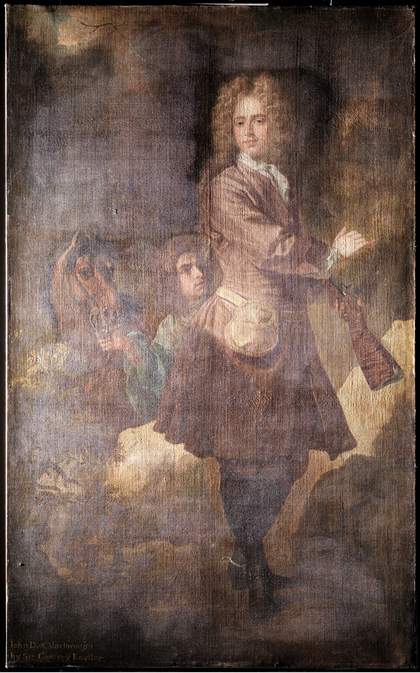
Fig.5
Portrait of a Gentleman in raking light from the left side
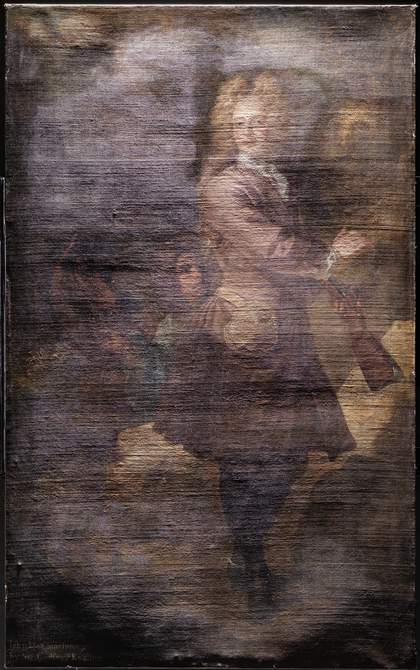
Fig.6
Portrait of a Gentleman in raking light from the top
The lead white based paint is much thinner than the ground layers, and includes mixtures of quite fine-grained pigments, and the same golden ochre, a natural earth that contains potassium. The paint has been applied thinly without impasto (figs.5–6). Pentimenti that can be seen with some difficulty through the varnish indicate minor compositional changes, such as extending the area of the sky over existing landscape paint. The flesh paint of the raised hand includes vermilion as well as more of the golden ochre, while the grey background includes a fine black pigment and a red lake. Almost all layers include yellow or brown earth pigments. At the right and near the gun, the foliage is painted over the cloudy sky in places, but the pale rock and the right hand are painted directly over the preparatory layers.
The paint appears in good condition for its age. There are numerous small areas of retouching throughout. Some are old and lie beneath the yellowed varnishes, for example discoloured retouching over canvas damages located towards the centre of the right edge. More recent retouching is also present, applied in 2005. There is a small, repaired puncture above the horse's head, which appears cracked and raised. Some tiny and old paint losses are scattered throughout. Cracking is present throughout.
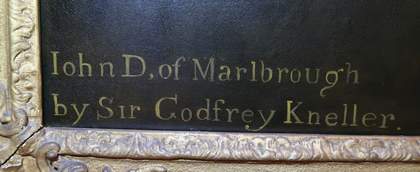
Fig.7
The inscription at lower left
The inscription at lower left (fig.7), ‘John D. of Marlbrough / by Sir Godfrey Kneller.’ is wrong for both sitter and artist. Its location within the several varnish layers has not been investigated.
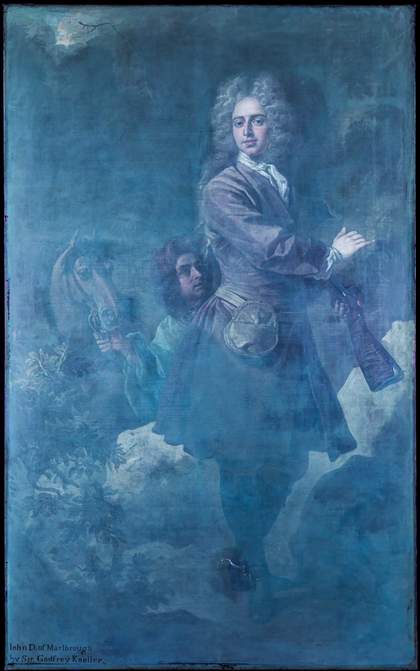
Fig.8
Portrait of a Gentleman viewed in ultraviolet light
Three natural-resin-type varnishes are present, with substantial dirt between, physically thin but much yellowed, with fine surface crazing. Collectively, they conceal much detail and colour. The head and body of the main figure down to the gunpowder bag on the belt have undergone local varnish reduction (fig.8). In 2005 an overall layer of MS2A resin varnish was brush applied at Tate on top of the existing varnishes.
This description concerns the painting before removal of the older, yellowed varnishes, which was recommended at acquisition. The images were also all taken with the older varnishes present.
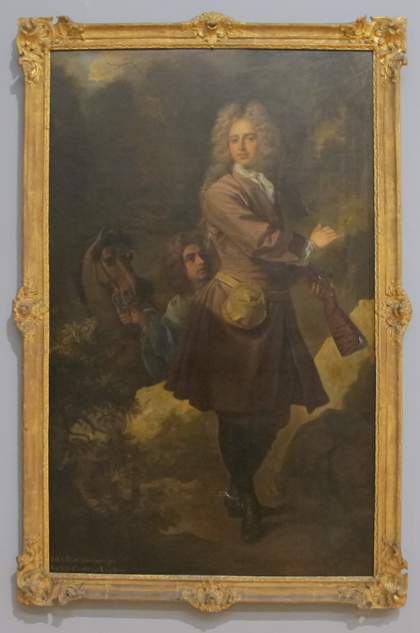
Fig.9
Portrait of a Gentleman in its frame
The painting is fitted in an unglazed wooden frame with corner and centre carved ornament (fig.9). The frame dimensions appear to have been altered; there are numerous joins visible along all members where additional wood sections have been inserted and the rebate edge is uneven. Ornament at the top right corner differs slightly from the other corners. The frame surfaces have been textured with sand, presumably to hide the structural alterations, before regilding at an unknown date, prior to arrival at Tate.
March 2022
